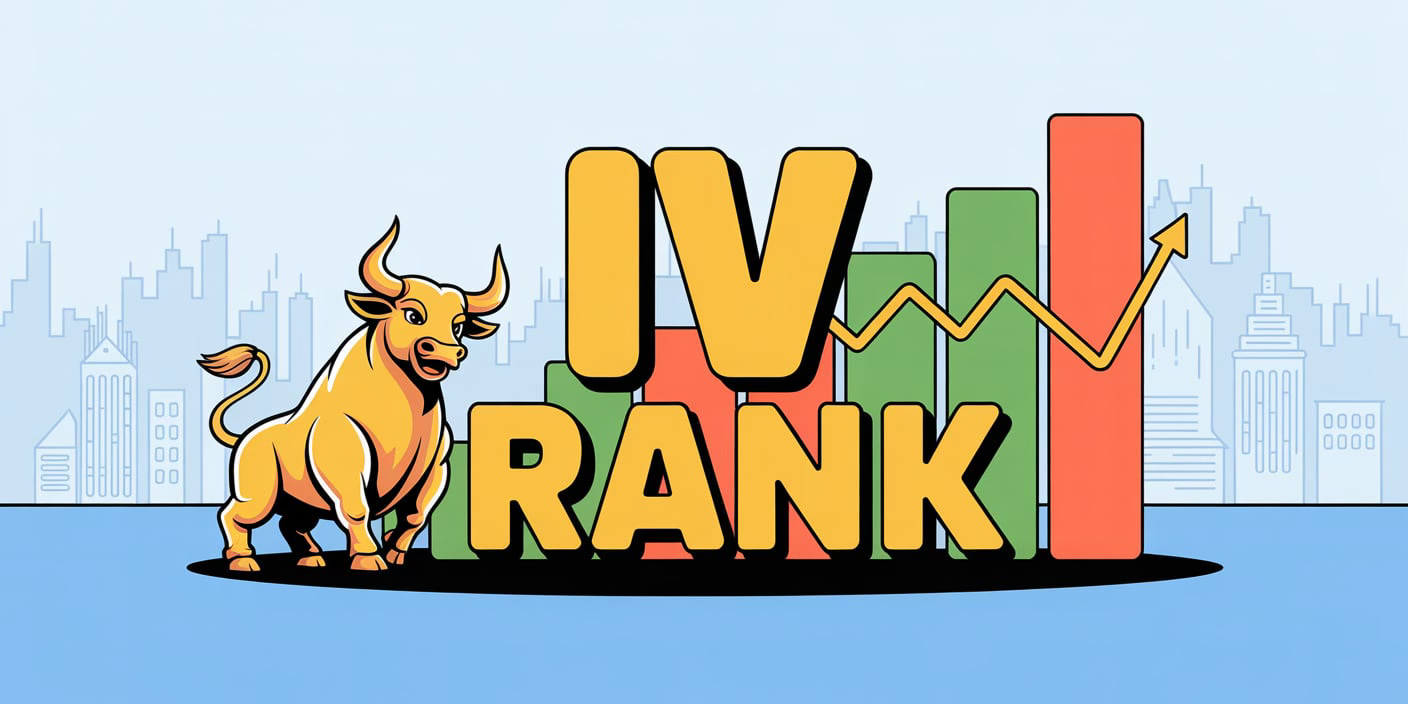In options trading, volatility isn’t just about how much a stock moves — it’s also about how expensive or cheap options are relative to history. One of the simplest and most powerful tools for gauging this is IV Rank (Implied Volatility Rank).
For beginners, IV Rank provides a way to quickly see if options are trading at high or low implied volatility compared to the past year. This insight can guide strategy selection, improve timing, and prevent costly mistakes.
What Is IV Rank?
IV Rank measures where a stock’s current implied volatility sits relative to its range over the past year (typically 52 weeks).
The formula is:
An IV Rank of 0% means current implied volatility is at its lowest point in the past year.
An IV Rank of 100% means it’s at its highest.
IV Rank Categories and Meanings
0–25% (Low IV Rank): Options are cheap. The market expects little volatility.
25–50% (Moderate IV Rank): Options are fairly priced. Neutral conditions.
50–75% (High IV Rank): Options are expensive. The market is pricing in big potential moves.
75–100% (Extreme IV Rank): Options are very expensive. Fear or uncertainty is elevated.
Low IV Rank Trading Strategies
When IV Rank is low, options are relatively cheap. This is when buying premium often makes sense:
Long Calls / Puts: Straight directional bets are more attractive because premiums are cheaper.
Debit Spreads: Vertical call or put spreads allow directional exposure at reduced cost.
Calendars / Diagonals: Benefit from low current IV and the possibility of IV expansion.
High IV Rank Trading Strategies
When IV Rank is high, options are expensive. This is when selling premium often works best:
Short Straddles / Strangles: Profit from volatility collapsing back to normal levels.
Iron Condors: Defined-risk premium-selling in overextended IV environments.
Covered Calls: Enhance returns by collecting inflated premiums.
Advanced IV Rank Strategies
For experienced traders, IV Rank can be used to layer in advanced approaches:
IV Rank + Technical Analysis:
Combine IV Rank with chart setups.
Example: If a stock is in consolidation with IV Rank > 70%, iron condors become attractive.
IV Rank + Earnings Trades:
Options tend to price in large moves before earnings.
Selling volatility into high IV Rank before earnings, and then buying it back after the “IV crush,” is a popular advanced play.
IV Rank Mean Reversion:
High IV Rank often reverts lower once catalysts pass.
Low IV Rank often rises again when uncertainty re-emerges.
IV Rank Filtering and Stock Selection
IV Rank can also be used as a filter to narrow down trade candidates:
High IV Rank (>50%): Focus on premium-selling strategies.
Low IV Rank (<25%): Focus on premium-buying strategies.
Exclude middle ranges if indecisive: This helps allocate capital only when there’s an edge.
Platforms like Thinkorswim, Tastyworks, and Interactive Brokers allow screening stocks by IV Rank.
Common IV Rank Mistakes
Confusing IV with IV Rank:
High implied volatility doesn’t always mean high IV Rank. A stock may always trade with high IV (like biotech), but its IV Rank could still be low relative to its history.
Trading Without Context:
A high IV Rank before earnings is normal. It doesn’t always mean a good trade unless you account for the event.
Ignoring Timeframe:
IV Rank is backward-looking (52 weeks). Market conditions can shift dramatically — always combine with fundamentals and catalysts.
How Traders Can Use IV Rank Every Day
Daily Scan: Add IV Rank to your watchlist. Quickly spot where options are overpriced or underpriced.
Strategy Matching: Use IV Rank to decide whether to be a buyer or seller of options.
Risk Management: High IV Rank means larger expected moves. Adjust position sizing accordingly.
Event Awareness: Use IV Rank spikes to identify upcoming catalysts (earnings, Fed meetings, economic reports).
Key Takeaways
IV Rank measures implied volatility relative to its past year’s range.
Low IV Rank favors buying options, high IV Rank favors selling options.
Advanced traders combine IV Rank with earnings, technical setups, and mean reversion ideas.
Screening stocks by IV Rank helps identify the best option setups daily.
Avoid common mistakes: don’t confuse IV with IV Rank, and always consider context.
Final Thoughts
IV Rank is one of the simplest yet most powerful volatility tools available to options traders. By showing where implied volatility stands relative to history, it tells you when options are expensive or cheap — and therefore which strategies are most likely to succeed.
For beginners, the first step is simple: add IV Rank to your watchlist and start observing how options behave when it’s high versus low. Over time, you’ll develop an intuitive feel for how to align strategies with volatility conditions — a skill that separates casual traders from consistently profitable ones.



